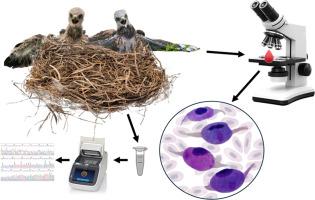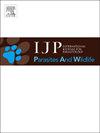立陶宛温带森林中雏鸟体内血孢子虫(Haemosporida)寄生虫的流行和本地传播情况
IF 2.2
3区 医学
Q3 ECOLOGY
International Journal for Parasitology-Parasites and Wildlife
Pub Date : 2024-10-29
DOI:10.1016/j.ijppaw.2024.101013
引用次数: 0
摘要
世界各地都有野生猛禽(咀齿目)感染血孢子虫寄生虫,众所周知,这些寄生虫会对它们的健康产生负面影响。由于这些鸟类在生态系统中的密度较低,保护状况较差,而且很难在野外接触到它们,因此对它们的研究较少。因此,在这项研究中,我们将重点放在立陶宛温带森林中繁殖后期可在巢中接触到的雏鸟身上。调查雏鸟体内的血孢子寄生虫对于了解当地寄生虫传播情况至关重要。为了确定在立陶宛传播的血孢子虫寄生虫种类,我们在2019-2022年对白尾海雕(Haliaeetus albicilla)、小斑海雕(Clanga pomarina)和普通鵟(Buteo buteo)的雏鸟进行了采样。采集了雏鸟的血样,并采用分子方法,使用特定引物(Plas1F/HaemNR3和3760F/HaemJR4)对寄生虫的细胞色素b(cyt b)基因片段进行测序。除分子技术外,我们还使用显微镜检查血液涂片,以确定是否存在寄生虫。我们的研究结果表明,雏鸟只感染了白细胞虫属,总感染率为 30.5%。不同年份的感染率相似,但与物种有明显的相关性。普通鵟雏鸟的感染率最高(80%),其次是小斑雕(29.2%)和白尾海雕(13.2%)。共发现了九个遗传系,其中五个是新发现的。我们的研究表明,在立陶宛,白细胞介体寄生虫会主动传播给雏鸟,而且发病率很高。本文章由计算机程序翻译,如有差异,请以英文原文为准。

Prevalence and local transmission of haemosporidian (Haemosporida) parasites in nestlings of birds of prey (Aves, Accipitriformes) in the temperate forests in Lithuania
Wild birds of prey (Accipitriformes) are infected with haemosporidian (Haemosporida) parasites worldwide, and it is known that these parasites can negatively affect their health. These birds are less studied due to their low densities in ecosystems, conservation status, and difficulty of accessing them in the wild. Therefore, in this study, we focused on nestlings of birds of prey that are accessible in their nests during late breeding stages in temperate forests in Lithuania. Investigating haemosporidian parasites in nestlings is crucial for understanding local parasite transmission. To identify the haemosporidian parasite species transmitted in Lithuania, we sampled nestlings of the white-tailed eagles (Haliaeetus albicilla), lesser spotted eagles (Clanga pomarina), and common buzzards (Buteo buteo) in 2019–2022. Blood samples were collected from the nestlings, and molecular methods were employed to sequence a fragment of the parasite's cytochrome b (cyt b) gene using specific primers (Plas1F/HaemNR3 and 3760F/HaemJR4). In addition to molecular techniques, microscopy was used to examine blood smears for the presence of parasites. Our results revealed that nestlings of birds of prey were infected only with Leucocytozoon spp., with an overall prevalence of 30.5%. The prevalence was similar between years, but it was significantly species-dependent. The common buzzard nestlings had the highest prevalence (80%), followed by the lesser spotted eagle (29.2%) and the white-tailed eagle (13.2%). A total of nine genetic lineages were identified, with five of them being novel. Our study demonstrates that Leucocytozoon parasites are actively transmitted to nestlings of birds of prey in Lithuania, with a high prevalence.
求助全文
通过发布文献求助,成功后即可免费获取论文全文。
去求助
来源期刊

International Journal for Parasitology-Parasites and Wildlife
Medicine-Infectious Diseases
CiteScore
3.80
自引率
5.60%
发文量
113
审稿时长
45 days
期刊介绍:
The International Journal for Parasitology: Parasites and Wildlife (IJP-PAW) publishes the results of original research on parasites of all wildlife, invertebrate and vertebrate. This includes free-ranging, wild populations, as well as captive wildlife, semi-domesticated species (e.g. reindeer) and farmed populations of recently domesticated or wild-captured species (e.g. cultured fishes). Articles on all aspects of wildlife parasitology are welcomed including taxonomy, biodiversity and distribution, ecology and epidemiology, population biology and host-parasite relationships. The impact of parasites on the health and conservation of wildlife is seen as an important area covered by the journal especially the potential role of environmental factors, for example climate. Also important to the journal is ''one health'' and the nature of interactions between wildlife, people and domestic animals, including disease emergence and zoonoses.
 求助内容:
求助内容: 应助结果提醒方式:
应助结果提醒方式:


